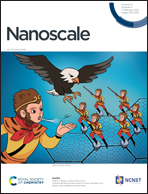Various half-metallic nodal loops in organic Cr2N6C3 monolayers†
Abstract
Topological nodal-line semimetals, as a type of exotic quantum electronic state, have drawn considerable research interest recently. In this work, we propose a new two-dimensional covalent-organic Cr2N6C3 monolayer (ML) material, which has a combined honeycomb and effective Kagome lattice and has various half-metallic nodal loops (HMNLs). First-principles calculations show that the Cr2N6C3 ML is dynamically and thermally stable and has an out-of-plane ferromagnetic order. Remarkably, various nodal loops, including types I–III, are found coexisting in the material, all of which are rare half-metallic states. The obtained HMNLs, simultaneously possessing the merits of spintronics and semimetals, are robust against spin–orbit coupling and biaxial strain. A topological phase transition, characterized by loop-winding indexes, can be induced in the ML by applying uniaxial strain. Tight-binding model calculations show that the obtained HMNLs originate primarily from the band inversion between Cr dx2−y2/xy and N pz orbitals, accommodated on the honeycomb and Kagome sublattices, respectively. The various predicted HMNLs and topological behaviors mean that the Cr2N6C3 MLs have promisingly versatile applications in future low-power-consuming spintronics and electronics.



 Please wait while we load your content...
Please wait while we load your content...